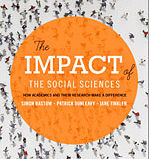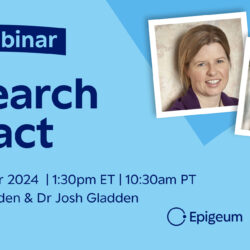The Impact of Social Sciences Project by the Numbers
Social Science Space often crossposts articles that first appeared at the London School of Economics Impact of Social Science blog. Social Science Space has also reported heavily on the Impact of Social Science project, which culminated in a book published by SAGE (Social Science Space’s parent). Here, one of the key players provides a valedictory for the project and a review of the blog’s own impact.
***
 Our Impact of the Social Sciences research project is now at an end. The first book from the project has been written and published and the second is half-way done. So it feels like a good time to look back and take stock of what was involved in the running of this four year project.
Our Impact of the Social Sciences research project is now at an end. The first book from the project has been written and published and the second is half-way done. So it feels like a good time to look back and take stock of what was involved in the running of this four year project.
Much of the ‘impact’ of academic work lies in the actual doing of it. It’s about the many connections that are made and the conversations that take place during the research, the dissemination of outputs and of course the development of ideas and thinking along the way. The research process is dynamic and changing and so the impact part of it doesn’t neatly fit onto the end.
Because of this, the lesson for academics is that we need to get better at recording and auditing impact-relevant research activities that happen all the way through a long-term project like this one. In many ways impact is about customer relationship management. We need to work out how to develop CRM ways of working in academia. We can start by recording activities more effectively in real time. And not letting impact-relevant knowledge dissolve away. So we decided to audit ourselves for the Impact project and this is a summary of what we found:
The research team
This felt like a fairly unusual social science project in that the research team involved was large and multi-disciplinary. The Impact research involved four research ‘labs’ that undertook projects that, we hoped, stood a good chance of having impacts over the three years. Two of these were within the LSE and two at other universities. The central team at the LSE was then able to use these as ‘live’ case studies as we worked on our core research questions.

This article by Jane Tinkler originally appeared on the LSE Impact of Social Sciences blog as “The Impact of Social Sciences Project by the numbers: encouraging real-time impact recording” and is reposted under the Creative Commons license (CC BY 3.0).
Also, as you would expect over a four-year project, the central team led by Simon Bastow, Patrick Dunleavy and myself also involved a number of researchers who worked with us for at least part of the research. To show the collaborative nature of the project we listed nine names alongside ours on the inside cover of the Impact book. We expect more social science projects to have larger research teams like this, representing a wider range of skills and expertise.
The blog
A large part of the project, one we didn’t in any way envisage when we started out, has been the Impact of Social Science blog. We originally planned to create a website to hold research outputs and share what the research labs were working on. But the central team had some previous experience with academic blogging, as we had created one on British politics a year before and we could see the positive effect it was having. And we thought that the growing interest from the higher education community around academic impacts would mean we wouldn’t find it too hard to get people to contribute.
That was absolutely the case, and the Impact blog is now seen as a core part of the higher education community. We have had over 1.5 million visits over the time the blog has been running and readership continues to grow. As authors of the Impact book, we are incredibly grateful to the blog contributors who updated us on so much about how academics themselves were thinking about and trying to create impact, often as they were doing so. The project and the resulting book would have been much poorer without them.
The 10 most popular posts on the LSE Impact of Social Science blog from outside the team:
The events
We have also worked on building a community off-line. We therefore put on five conferences (some whole day and some shorter) over the four years. The first conference, Investigating Academic Impact, was held in June 2011, and around 400 people attended. We also created podcasts of the presentations and nearly 26,000 have listed to those sessions. The final conference, called The Future of Impacts, held in December 2013 attracted around 500 attendees. We ran a series of breakout sessions that provided ‘how to’ guides to using social media. The presentations and podcasts from all our events are still available:
- Engaged Social Science: Impacts and Use of Research in the UK (Jan 2014)
- Social Science in the Public Sphere: Riots, Class and Impact (July 2013)
- The Future of Academic Impact (December 2012)
- From Research to Policy: Academic Impact on Government (March 2012)
- Investigating Academic Impact (June 2011)
Other events looked at: public social science projects, like the Guardian/LSE’s Reading the Riot project; the impact of academic work on government and policymaking (with the Institute for Government); and the impact of research on climate change on government and business (with the Grantham Institute at Imperial). Across all our events, we have reached 55,332 people through recording and disseminating podcasts after the events.
American edition
An American edition of The Impact of Social Sciences book, with a new foreword by Ken Prewitt, will be launched this month.
In addition members of the central team have presented findings of our research at 34 conferences and workshops organised by universities, funding councils, government bodies and learned societies, over the course of the project.
Our final event was to launch our book in January this year. We put together a panel to represent each of our four key sectors: the media (Mark Easton, Home Editor, BBC News), business (Jeff Patmore, former Head Strategic University Research & Collaboration, British Telecom), government (Aileen Murphie, Director, Local Government VFM, National Audit Office) and civil society (Penny Lawrence, International Programmes Director, Oxfam GB). About 350 people came on the day but since then the podcast of the event has been downloaded nearly 8,500 times. During the event our hashtag #impactsocsci was a trending topic in the UK (the full Storify for all the tweets is here).
The outputs
A large number of outputs came from the research. The most frequent type of output at the moment is research reports for government bodies, both local authorities and central government departments. This reflects the focus on the work of the labs on the impact of academic work on policy. But it also reflects the long time-lags for academic publications where articles written one and two years ago are only just appearing in print.
And for the central team, we produced some key resources that have been widely used and shared via the Impact blog. We produced a Handbook that aimed to provide some direction for individual academics and university managers to think about the impact of their research. And our guide for academics on using Twitter has been downloaded over 55,000 times since we published it three years ago. With these outputs and the Impact book, we estimate that just the central team has published nearly a quarter of a million words on impact.
| Title | Published | Views |
|---|---|---|
| Twitter Guide | September 2011 | 55,605 |
| Academic Tweeters: Your lists in full | September 2011 | 26,308 |
| 5 Minute interview with Patrick | February 2012 | 12,558 |
| Your essential ‘how-to’ guide to writing good abstracts | June 2011 | 16,060 |
| Why do academics choose useless titles for articles and chapters? Four steps to getting a better title | February 2014 | 15,438 |
Totals given here are page views.
We think these figures give a good overview of the types of activities and interactions we achieved during the research. But it does still leave a question: How can we be more systematic about recording our impact-relevant activities in real time? There will no doubt be some metrics that are more useful than others, some that are easier to collect than others. The impact case studies submitted to REF will give a unique insight into both the activities that lead to impact but also the information that is most useful when describing impact. Until then, we hope this is a good start.























































































